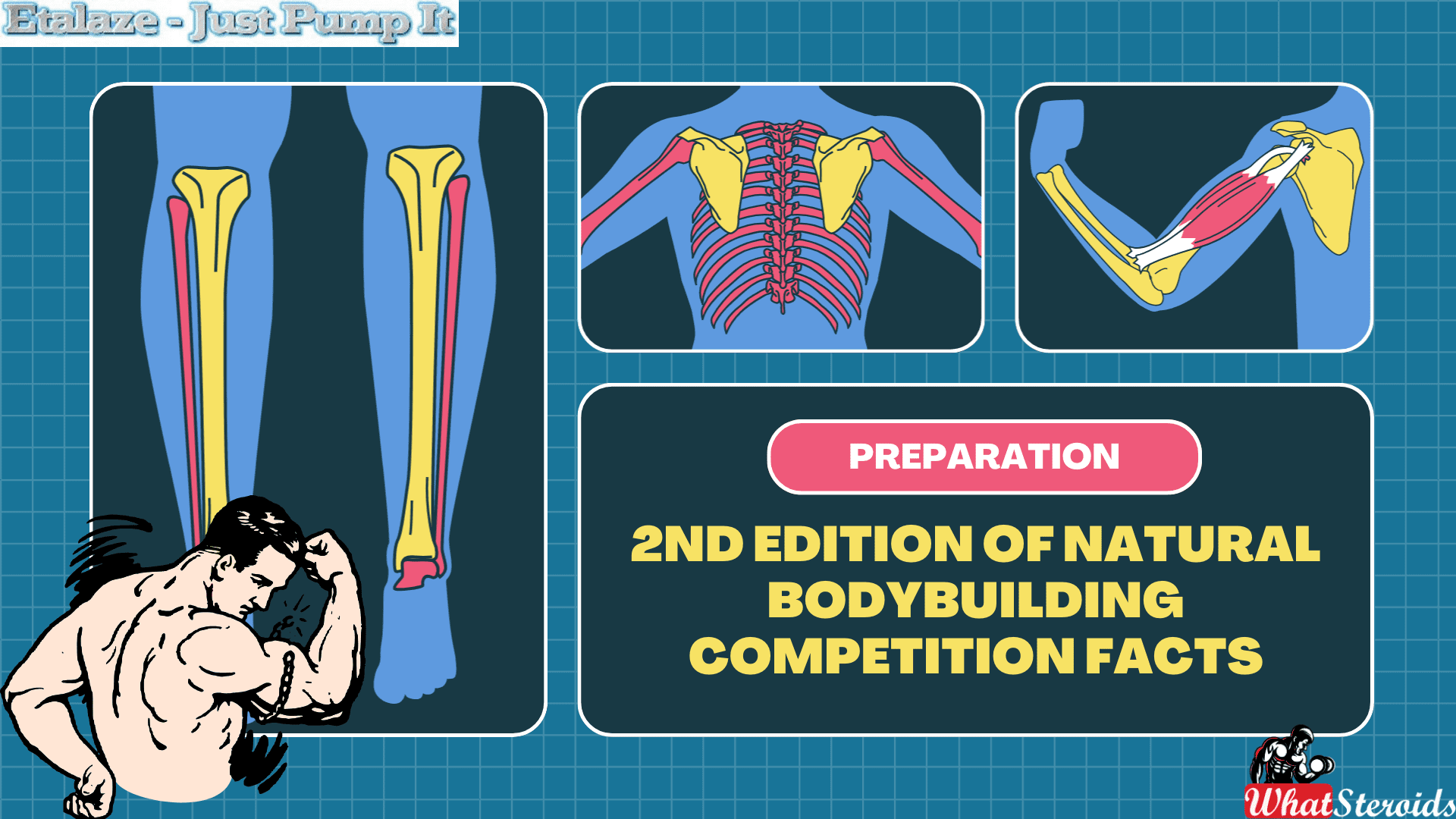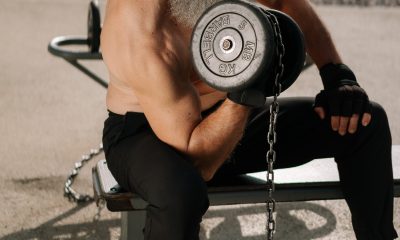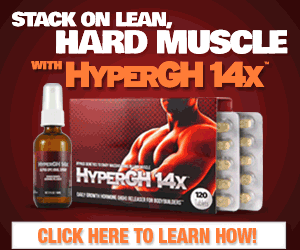Bodybuilding
How to Train With Expander Cable
Expander cables are a great alternative to heavy training. Being a bodybuilders you have to know that from time to time you need to layoff of big weights training in order to avoid adaptation and to ensure further muscle growth. There are many alternatives such as dumbbells, or barbells but only expander cables exercises do not get you overtraining so easy. That's why you have to add expander exercise to your training program and do it regularly.
Expander exercises very well develop muscle arms, especially the shoulder joint, and trunk muscle. The expander is a simple piece of equipment consisting of many parts. Namely, from the springs, but can be used with rubber bands attached to two handles. You can also increase the load for each set by adding a new spring.
If you choose to do expander exercise than you need to gradually increase the load. Do the first one 1-2 sets of exercises with one spring. Once you will be able to perform the established number of repetitions per exercise with no difficulties, you can increase the number of springs or approaches. Also, when you do exercises, check for expander cable to constantly come to the starting position slowly, with little resistance, without relaxing muscles.
If you are about to start expander exercises than in the first sessions include 5-6 sets of 7-8 reps. Take a pause of 30 seconds between exercises. The duration of training start from 10-15 minutes and have to be increased gradually to 30 minutes. Also, the number of reps increase 12 for each set.
A great advice for you before beginning expander cable workout has properly defined the purpose of your training. As you know, firstly you must get rid of fat, and only after this, you begin to work on muscle building. Otherwise, muscles mass will be covered by fat, and you will get a lean muscle body.
Depending on your goal, you will select a specific set of exercises, the load level and an effective number of reps. If you want to lose weight, and strengthen muscles that are chosen exercises for all muscle groups with a focus on problem areas such as abs, chest, legs, back, arms or shoulders.
Do not forget to warm-up before training for 10 minutes including aerobic and cardio exercise. The duration of basic training takes up to 30 minutes. Try to work firstly largest muscles, such as legs and back. Exercise has to be performed at a rapid pace while trying to make a second pause at the moment of maximum muscle contraction.
Must Read: The Benefits of Warm Up Exercises Before Workout
If you want to increase strength and muscle mass, then training is the same as in case of free weights workout. Firstly warm-up, and then do exercises for 30 minutes. Do 6-15 reps for each exercise, with a one minute pause between each set.
By performing less than 6 reps you develop strength, and if you exceed 15 reps you develop muscle endurance. The same rapid pace tempo is required, with a one-second pause in the maximum point. For achieving results, do not forget to increase the number of reps each week.
Let’s see further five most common expander cable exercises for building a different group of muscles.
Pull a Part Expander Cable Exercise:
 Attach the expander cable to a fixed support, such as racks for squats. Standing with your feet together, and handle in each hand, extend your hands outwards slowly and smoothly.
Attach the expander cable to a fixed support, such as racks for squats. Standing with your feet together, and handle in each hand, extend your hands outwards slowly and smoothly.
You will feel how deltoid, trapezius muscles get flexed. Hold this position for a second. Then slowly return the arms to the starting position. Once again press your hand's hands apart, and so on.
This exercise trains the side and rear beams deltoid, trapezius muscles. In order to gradually increase the load, you will have to increase the number of reps.
Upright Rows With Expander:

Stand with your feet in the middle of the expander. Adjust its length so that the tension of the expander begins in drooping hands. Stand up straight, do not slouch. Turn the palms to the hips.
Gently pull up along the expander body. At the same time, spread your elbows to the side, but hold his hand close to his body.
When pulling expander to the chin, make a one-second pause. Feel the work of trapezius muscles. Then slowly return the arms to the starting position. Once again pull up the expander. Repeat the movement as many times as you can. Do the exercise until exhaustion.
Exercise For The Middle Back:

Fix expander at the level of the knee. Knees have to be slightly bent, back straight, your abdominal muscles are tense, expander in the tense situation.
On the exhale, bendable arms, bringing the shoulder blades together, then return to starting position and inhale.
When performing this exercise back should always be straight, shoulders should be kept together, to feel your back muscles. Three sets of 25 reps would be enough for this type of exercise.
Expander Cable Exercise For Buttocks and Thighs:

This type of exercise greatly improves the shape of the buttocks and thighs. Get on your knees and elbows. Fasten the ends of the expander on the feet. Lift one leg back and up, bending at the knee (as if you want to push the ceiling), and the other remains in place. Perform 10-15 repetitions with both feet.
Pull Back on Top Exercise:
 This exercise strengthens the trapezius and latissimus dorsi muscle. Standing position, with your feet at shoulder width apart, and hands with expander are extended above the head. On the exhale, draw a shock absorber, shoulder blades will be reduced, and the return to an initial inspiration the elbows should be slightly bent and immobile, shoulders are not raised. Three sets of 10-15 reps for this exercise would be enough.
This exercise strengthens the trapezius and latissimus dorsi muscle. Standing position, with your feet at shoulder width apart, and hands with expander are extended above the head. On the exhale, draw a shock absorber, shoulder blades will be reduced, and the return to an initial inspiration the elbows should be slightly bent and immobile, shoulders are not raised. Three sets of 10-15 reps for this exercise would be enough.
Have to be said that breath while performing expander cable exercise is very important. According to statistics, one of the main causes of heart disorders over age 40 in case of at least 50% of bodybuilders is incorrect breathing during weight training.
As you observed holding the breath when straining increases strength, but at the same time, it affects the heart muscle. If you use to do 1-2 reps per set, then it has a short-term side effect and does not lead to the development of cardiovascular diseases.
While the big number of sets performed by holding breath when straining has different consequences. It increases the risk of coronary heart disease, arrhythmias, and many other complex disorders of the heart. Worst of all, breath holding leads to an immediate rise in blood pressure. Over time, high blood pressure may lead to strokes and heart attacks.
Holding breathing while straining leads to a weakening of the blood flow to the working muscles. Oxygen is an important agent of muscle growth. The more oxygen in the blood, the better. Frequent breath holding during strength training reduces the oxygen level in the blood, and, to its lowest level when it comes to vertigo.
Thus, during workout monitor your breath until you will practice the rhythm automatically. During one rep you have to take a full breath. From the technical point of view this is the right way of breathing during an exercise: inhale before the first repetition, exhale on the phase of maximum stress and inhale in the negative phase of the movement.
That being said, let’s point out some very important rules to follow during expander cable exercises.
-First of all, never miss warm-up. It will keep you away from any injury and make your muscles ready for work. An injury can keep you out of the gym for a long time, and surely no one wants it.
-Use the most rigid models of expander arsenal for maximum effort. Also, you can even use two expanders for more resistance.
-Avoid getting overtraining. Get rest breaks between sets, and training as well. A three times a week expander cable workout is quite enough.
-Pay attention to right execution. Pull your hands apart until the final moment, and then slowly return to the initial position.
In conclusion, can be said that expander cable is a great tool to build muscle mass. They are easy to store and you can take it everywhere with you. Also, expander exercise can be used when no other weight training is allowed. Cable exercise greatly help to increase chest muscle, improve breathing capacity and has a massage effect on internal organs. Along with chest muscle, it helps to work for deltoid, biceps, triceps, lats, forearms muscle group too.
Must Read: How To Build Deltoid Muscle
However, for great results in muscle growth, you have to follow the right way of execution and to breathe properly. These factors are crucial in all bodybuilding exercises and you have to make them your golden rule. Just bear it in mind and every time you get tempted to cheat or are absent-minded remember that they make your workout efficient.
Bodybuilding
Mastering Bodybuilding in 2025: Top Fitness Tips for Success

Bodybuilding is more than just a sport; it's a lifestyle that requires dedication, discipline, and a thorough understanding of fitness principles. As the world of fitness continues to evolve, bodybuilders must stay updated with the latest trends, techniques, and scientific advancements to achieve their goals. In 2025, several innovative approaches are redefining bodybuilding. Here are essential fitness tips for bodybuilders to excel this year.
Read More: Bodybuilder Winter Clothing: Staying Warm and Stylish
Embrace Technology-Driven Workouts
In 2025, technology plays a significant role in bodybuilding. Wearable devices, fitness apps, and virtual reality (VR) training are now integral components of an effective workout regimen.
Wearable Devices
Modern wearables track everything from heart rate and sleep patterns to muscle activation and caloric expenditure. Utilize these devices to monitor your progress and make data-driven adjustments to your training and nutrition plans.
Fitness Apps
Leverage fitness apps for customized workout plans, progress tracking, and virtual coaching. Many apps now incorporate artificial intelligence to provide personalized feedback and recommendations.
Virtual Reality Training
VR technology offers immersive workout experiences, allowing bodybuilders to simulate different training environments and scenarios. This can enhance motivation and add variety to your routine.
Focus on Functional Strength
While hypertrophy (muscle growth) remains a primary goal, functional strength is gaining importance. Functional strength training improves overall performance, reduces the risk of injury, and enhances daily activities.
 Check Out Our1 4 Weeks Quality Strength & Lean Muscles
Check Out Our1 4 Weeks Quality Strength & Lean Muscles
Compound Movements
Incorporate compound exercises like squats, deadlifts, and bench presses. These movements engage multiple muscle groups and joints, promoting balanced strength development.
Core Stability
Prioritize exercises that strengthen the core, such as planks, Russian twists, and leg raises. A strong core supports better lifting mechanics and reduces the risk of lower back injuries.
Optimize Nutrition for Muscle Growth and Recovery
Nutrition is the cornerstone of successful bodybuilding. In 2025, the focus is on personalized nutrition plans tailored to individual needs and goals.
Protein Intake
Ensure adequate protein intake to support muscle repair and growth. Aim for 1.6 to 2.2 grams of protein per kilogram of body weight per day, depending on your training intensity and goals.
 Click Here to Buy SynthaTrope By SynthaPharma
Click Here to Buy SynthaTrope By SynthaPharma
Nutrient Timing
Pay attention to nutrient timing to maximize muscle recovery and growth. Consume protein and carbohydrates within 30 minutes post-workout to replenish glycogen stores and kickstart muscle repair.
Supplements
Utilize supplements wisely. Creatine, branched-chain amino acids (BCAAs), and omega-3 fatty acids are popular choices for enhancing performance and recovery.
Prioritize Mental Health and Mindfulness
Mental health is increasingly recognized as a critical component of overall fitness. Incorporating mindfulness practices can improve focus, reduce stress, and enhance performance.
Meditation
Incorporate meditation into your daily routine to reduce stress and improve mental clarity. Mindfulness meditation can enhance your mind-muscle connection during workouts.
Visualization
Use visualization techniques to mentally rehearse your workouts. Visualizing successful lifts and achieving your goals can boost confidence and motivation.
Rest and Recovery
Prioritize rest and recovery to prevent burnout and overtraining. Ensure you get 7-9 hours of sleep per night and incorporate rest days into your training schedule.
Leverage Advanced Training Techniques
Advanced training techniques can help break through plateaus and stimulate muscle growth. In 2025, several methods are gaining popularity among bodybuilders.
Blood Flow Restriction (BFR) Training: BFR involves restricting blood flow to the muscles during low-intensity exercises. This technique can enhance muscle growth and strength without the need for heavy weights.
Eccentric Training: Focus on the eccentric (lowering) phase of exercises. Eccentric training can stimulate greater muscle damage and growth compared to traditional concentric movements.
Periodization: Implement periodization into your training plan. Varying the intensity, volume, and type of exercises can prevent plateaus and ensure continuous progress.
Incorporate Recovery and Mobility Work
Recovery and mobility are essential for preventing injuries and maintaining optimal performance. In 2025, bodybuilders are paying more attention to these aspects of training.
Foam Rolling and Myofascial Release: Use foam rollers and massage balls to release muscle tightness and improve flexibility. Regular myofascial release can reduce soreness and enhance recovery.
Stretching: Incorporate dynamic stretching before workouts and static stretching after workouts. Stretching improves range of motion and prevents muscle imbalances.
Cryotherapy and Hydrotherapy: Explore recovery techniques like cryotherapy (cold therapy) and hydrotherapy (water therapy) to reduce inflammation and accelerate muscle recovery.
Engage in Continuous Learning and Community Building
The fitness industry is constantly evolving, and staying informed is crucial for success. Engage in continuous learning and connect with the bodybuilding community for support and motivation.
Educational Resources: Read books, watch videos, and attend seminars to stay updated on the latest research and trends in bodybuilding.
Community Engagement: Join online forums, social media groups, and local bodybuilding clubs. Sharing experiences and knowledge with fellow bodybuilders can provide valuable insights and encouragement.
Professional Guidance: Consider working with a certified personal trainer or coach. Professional guidance can help you optimize your training and nutrition plans, ensuring you're on the right track.
With your FB Plus subscription or active FB Plus Pass, you now have access to 124 weeks of our most popular workout programs, which typically sell for $10-$30 each. Additionally, our popular 4-week Meal Plan is included. This is on top of the 38 Challenges and Programs that are already available to Plus members.
We've also introduced a new feature that many of you have requested. To assist you in choosing your next program, you can now preview each day of any program from its detail view. This feature lets you see all the included workout videos and content before you schedule it, ensuring you know exactly what to expect.
Conclusion
In 2025, bodybuilding is more than just lifting weights; it's a holistic approach to fitness that encompasses technology, nutrition, mental health, and advanced training techniques. By embracing these fitness tips, bodybuilders can achieve their goals, stay injury-free, and enjoy a fulfilling fitness journey. Remember, consistency and dedication are key to success in bodybuilding. Stay committed, keep learning, and most importantly, have fun on your path to becoming the best version of yourself.
Bodybuilding
Top Video Games for Bodybuilders in 2025

There are several video games that can be great for bodybuilders, combining fitness and fun! Here are some of the best options:
Ring Fit Adventure (Nintendo Switch)
The game uses the Ring-Con and Leg Strap to guide you through various exercises and adventures. It's a fun way to get a full-body workout while playing a game.
Fitness Boxing 2: VR Boxing Remastered (PlayStation VR)
It offers a full-body boxing workout with a variety of punches and combos. It's a great way to improve your fitness while enjoying a virtual boxing experience.
Must Read: Marvel-Inspired Training Clothing on Amazon
Just Dance 2024
This popular dance game gets you moving to the beat with a variety of songs and dance routines. It's a fun way to burn calories and improve your coordination.
Zumba Fitness
Burn It Off (Nintendo Wii): This game offers a fun and energetic Zumba workout, perfect for those who enjoy dancing and want to get a good cardio workout.
Yoga for Beginners
If you're looking for a more relaxing workout, yoga games can help improve flexibility and reduce stress. Many of these games offer guided yoga sessions that you can follow along with.
Gym Tycoon
This game lets you build and manage your own gym, complete with various workout equipment and fitness classes. It's a great way to learn about different exercises and how to create effective workout routines.
The Sims 4: Fitness Stuff Pack
This expansion pack for The Sims 4 adds fitness equipment and activities to the game, allowing you to improve your character's fitness and join the athlete career.
Grand Theft Auto: San Andreas
While not a traditional fitness game, this classic game includes bodybuilding activities that can help your character gain muscle and improve fitness.
Knockout Home Fitness (Nintendo Switch)
This game offers a variety of boxing workouts that can help improve your strength and endurance.
Gym Simulator 24 (PC)
In this simulation game, you can build and manage your own fitness empire, creating workout routines and managing gym equipment.
Let's Get Fit (Nintendo Switch)
This game focuses on pure workouts, allowing you to set programs and follow along with digital trainers for a customized fitness experience.
Beat Saber (VR)
A popular VR game where you slash blocks to the beat of the music, providing an intense full-body workout.
Synth Riders (PlayStation VR)
This game combines freestyle dance and fitness, offering high-tempo tracks and multiplayer modes for a fun and energetic workout.
Yoga Master (PlayStation)
Designed by professional yoga coaches, this game offers a variety of yoga lessons and poses to improve flexibility and reduce stress.
Les Mills Bodycombat (PlayStation VR)
A martial arts-inspired workout game with a range of workout plans and coaching to keep you motivated.
OhShape Ultimate (PlayStation VR)
This game provides a full-body cardio workout with six sessions and two difficulty levels, designed to engage every part of your body.
These games offer a mix of cardio, strength, and flexibility workouts, making them great additions to your fitness routine.
Related Article: Supplemental Breast Milk for Bodybuilders
Bodybuilding
2nd Edition of Natural Bodybuilding Competition Facts

Natural bodybuilding competitions are designed to promote and celebrate athletes who build their physiques without the use of performance-enhancing drugs. These events emphasize fair play, health, and the natural development of muscle mass and definition.
The second edition of natural bodybuilding competitions has gained momentum globally, particularly focusing on drug-free athletes. These competitions are hosted by various organizations like the INBA/PNBA (International Natural Bodybuilding Association/Professional Natural Bodybuilding Association) and OCB (Organization of Competitive Bodybuilders).
In 2024, several notable events have been planned, including the INBA Natural Universe and INBA World Cup, both of which emphasize natural bodybuilding through rigorous drug testing policies. These events aim to showcase competitors who adhere to strict drug-free protocols, and winners often earn pro cards allowing them to compete in higher-level professional competitions.
These competitions focus on categories like men's bodybuilding, classic physique, and women's figure and bikini, among others. Athletes undergo polygraph and urine tests to ensure compliance with natural bodybuilding standards. The winners often receive medals, trophies, or pro status
-

 Steroids2 years ago
Steroids2 years agoVOX Testing: Why Bodybuilders Must Have It Tested Regularly
-

 Steroids2 years ago
Steroids2 years agoShavers and Other Body Grooming Equipment for Bodybuilders In 2023
-

 Steroids2 years ago
Steroids2 years agoChatGPT and Other Avenues to Find Great Bodybuilding Coaches
-

 Steroids2 years ago
Steroids2 years agoBest Oil Recommendations Before Competition for Subtle Shimmer
-

 Steroids2 years ago
Steroids2 years agoPowerlifting Vs Power Building: Find Out the Big Difference and When to Shift Between the Two
-

 Nutrition1 year ago
Nutrition1 year agoEverything Nutritional Food: What’s Too Much Or Too Little
-

 Bodybuilding Products12 months ago
Bodybuilding Products12 months agoTelmisartan In Bodybuilding: An Expert’s Advice
-

 Anabolic Steroids1 year ago
Anabolic Steroids1 year agoLegality of Anabolic Steroids In Latin America
-

 Beginners2 years ago
Beginners2 years agoTren Cycle for Beginners
-

 Bodybuilding1 year ago
Bodybuilding1 year agoList of FDA-Approved Peptides
-

 Bodybuilding2 years ago
Bodybuilding2 years agoCompetition Prep Cycle for Pro Bodybuilders
-

 Bodybuilding1 year ago
Bodybuilding1 year agoChia Seeds in A Bodybuilder’s Diet: An Expert’s Advice
-

 Bodybuilding7 months ago
Bodybuilding7 months agoPrimal Movements: Our Ultimate Guide for Maximum Results
-

 Anabolic Steroids11 months ago
Anabolic Steroids11 months agoHow Much Do You Know About B-AET? A Fat Burner You’ve Been Missing
-

 Steroids11 months ago
Steroids11 months agoAnadrol Cycle: Benefits, Doses, Alternatives, etc.
-

 Anabolic Steroids8 months ago
Anabolic Steroids8 months agoJoint Stiffness: How to Manage It While on AAS
-

 Steroids9 months ago
Steroids9 months agoOmnitope (Oxytocin)
-

 Bodybuilding1 year ago
Bodybuilding1 year agoHow Much Is Too Much Cardio? Understanding Heart Rate Zones
-

 Product Reviews10 months ago
Product Reviews10 months agoTop Vitamins for Skin Health
-

 Bodybuilding8 months ago
Bodybuilding8 months agoHow Effective is Bone Broth for Recovery?
-

 Steroids10 months ago
Steroids10 months agoMajor Bodybuilding Peptides Explained
-

 Steroids8 months ago
Steroids8 months agoSleeping Positions for Effective Muscle Recovery
-

 Bodybuilding9 months ago
Bodybuilding9 months agoHormone Replacement Therapy (TRT) Cycle Guide
-

 Anabolic Steroids1 year ago
Anabolic Steroids1 year agoStart The New Year Strong With These Tips
-

 Bodybuilding1 year ago
Bodybuilding1 year agoCalorie Dumping: A Bodybuilder’s Guide


















 Click here to buy 1-Test Cyp/DHB 100 by Dragon Pharma
Click here to buy 1-Test Cyp/DHB 100 by Dragon Pharma









